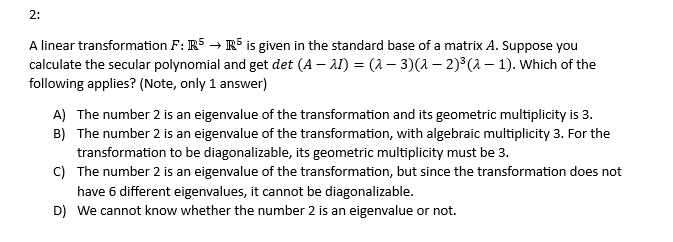2: A linear transformation F: R5 → R5 is given in the standard base of a matrix A. Suppose you calculate the secular polynomial and get det (A − 2) = (λ − 3)(a − 2)³(2-1). Which of the following applies? (Note, only 1 answer) A) The number 2 is an eigenvalue of the transformation and its geometric multiplicity is 3. B) The number 2 is an eigenvalue of the transformation, with algebraic multiplicity 3. For the transformation to be diagonalizable, its geometric multiplicity must be 3. C) The number 2 is an eigenvalue of the transformation, but since the transformation does not have 6 different eigenvalues, it cannot be diagonalizable. D) We cannot know whether the number 2 is an eigenvalue or not.
2: A linear transformation F: R5 → R5 is given in the standard base of a matrix A. Suppose you calculate the secular polynomial and get det (A − 2) = (λ − 3)(a − 2)³(2-1). Which of the following applies? (Note, only 1 answer) A) The number 2 is an eigenvalue of the transformation and its geometric multiplicity is 3. B) The number 2 is an eigenvalue of the transformation, with algebraic multiplicity 3. For the transformation to be diagonalizable, its geometric multiplicity must be 3. C) The number 2 is an eigenvalue of the transformation, but since the transformation does not have 6 different eigenvalues, it cannot be diagonalizable. D) We cannot know whether the number 2 is an eigenvalue or not.
Linear Algebra: A Modern Introduction
4th Edition
ISBN:9781285463247
Author:David Poole
Publisher:David Poole
Chapter4: Eigenvalues And Eigenvectors
Section4.3: Eigenvalues And Eigenvectors Of N X N Matrices
Problem 9EQ
Related questions
Question
please choose the true option

Transcribed Image Text:2:
A linear transformation F: R5 → R5 is given in the standard base of a matrix A. Suppose you
calculate the secular polynomial and get det (A − 2) = (2-3)(a − 2)³(λ — 1). Which of the
following applies? (Note, only 1 answer)
A) The number 2 is an eigenvalue of the transformation and its geometric multiplicity is 3.
B) The number 2 is an eigenvalue of the transformation, with algebraic multiplicity 3. For the
transformation to be diagonalizable, its geometric multiplicity must be 3.
C) The number 2 is an eigenvalue of the transformation, but since the transformation does not
have 6 different eigenvalues, it cannot be diagonalizable.
D) We cannot know whether the number 2 is an eigenvalue or not.
Expert Solution
This question has been solved!
Explore an expertly crafted, step-by-step solution for a thorough understanding of key concepts.
Step by step
Solved in 3 steps with 3 images

Recommended textbooks for you

Linear Algebra: A Modern Introduction
Algebra
ISBN:
9781285463247
Author:
David Poole
Publisher:
Cengage Learning

Elementary Linear Algebra (MindTap Course List)
Algebra
ISBN:
9781305658004
Author:
Ron Larson
Publisher:
Cengage Learning

Linear Algebra: A Modern Introduction
Algebra
ISBN:
9781285463247
Author:
David Poole
Publisher:
Cengage Learning

Elementary Linear Algebra (MindTap Course List)
Algebra
ISBN:
9781305658004
Author:
Ron Larson
Publisher:
Cengage Learning